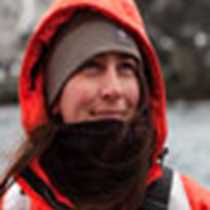We began our day under gray skies at dawn with an early morning beach landing. This is arguably one of the most exciting landings of the expedition, with many, many birds in every direction. We went ashore in Darwin Bay, on a small beach inside a giant caldera. We were greeted by Nazca and red-footed boobies. There were fluffy white chicks begging for food from their parents, birds swooping in with loud squabbling, and a few amorous avian couples. We had a couple of hours on shore with our naturalists telling us about the birds and their life cycles and behavior. Photographers went nuts shooting everything that moved. This was our first encounter with the red-footed boobies, which was quite popular. Many swallow-tailed gulls were nesting in the area. Pairs groomed one another with half-closed eyes, and a few revealed large speckled eggs as we passed. There were also frigate birds gearing up for the breeding season, and at least one male was spotted with its large red pouch inflated for the viewing pleasure of nearby females. The tide was rising, and part of the walk was submerged about knee deep in warm water. We walked slowly, watching herons, gulls and boobies. After breakfast, snorkelers and kayakers headed out onto the water under a hot sun and blue sky. Snorkelers were rewarded with exciting views of various marine species and kayakers enjoyed a fairly tranquil day in the caldera.
In the afternoon, hikers headed to shore. The hike began with a dramatic 90-foot climb up Prince Phillip's Steps, so named for Prince Phillip (the Duke of Edinburgh) after his visit in the 1960s. Several red-billed tropicbirds flew past to the delight of photographers, and some were landing at nearby nests on the cliffs. Once atop the island, we hiked on an easy trail past uncounted numbers of boobies – Nazca and red-footed. There were many chicks of varying ages, from newly hatched to some as large as their parents. There always seems to be a high degree of drama in the booby colonies, much to the entertainment of their human visitors. The highlight of the hike, however, was the Galapagos short-eared owls. We spotted two of them, one right along the side of the trail. These small raptors are diurnal and are the top predators of the island. For those who did not hike, a Zodiac tour headed outside the caldera to visit a large bird colony and was a favorite Zodiac tour of the week.
The evening wrapped up with the guest slide show followed by Captain's dinner. It was a wonderful expedition this week in the Galapagos!









